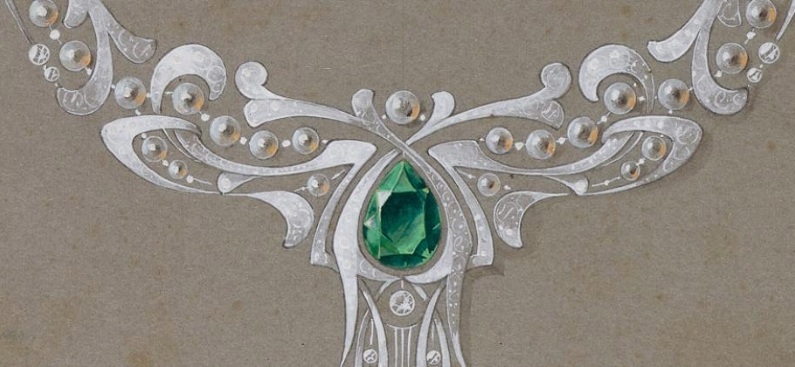Young and stunning, with perfectly sculpted eyebrows and a head of rich brunette curls, French actress Sarah Bernhardt first captured the hearts of Paris’s theatre-going elite in the 1870s. It wasn’t long before the rest of the world took notice. Critics, reaching for poetic metaphors, likened her voice to pure gold, a nightingale, silver dawn, the stars and moon, and murmuring water.
Sarah Bernhardt was in a class all her own—the Marilyn Monroe of the French Belle Époque. “There are five kinds of actresses,” declared American writer Mark Twain. “Bad actresses, fair actresses, good actresses, great actresses—and then there is Sarah Bernhardt.”
However gifted and alluring she was, stardom like Sarah’s wasn’t achieved in isolation. One of the most captivating aspects of her presence occurred offstage, along the bustling boulevards of Paris. Striking promotional posters by Czech artist Alphonse Mucha propelled Bernhardt from a well-respected actress to an international icon at the turn of the century, creating lasting memories of her electric mystique. In turn, Bernhardt\’s influence helped cement Mucha\’s success in the vibrant Parisian art world.
The meeting between Sarah Bernhardt and Alphonse Mucha was serendipitous. In late December 1894, Mucha, a struggling Czech illustrator, was temporarily working at the prominent Paris printing firm Lemercier & Compagnie while the regular professional artists were away celebrating the holidays with their families.
Desperate to promote her upcoming show at the Théâtre de la Renaissance, Bernhardt approached Lemercier just after Christmas. She needed a poster for her Greek melodrama, Gismonda, which was debuting shortly after the New Year. As both director and lead actor, playing a widow of the Athenian nobility who pledges herself to a commoner, Bernhardt needed the poster immediately. Despite his lack of experience in poster design, Mucha was tasked with creating something for the esteemed actress.
Mucha designed a stylized, monumental, full-sized portrait of Bernhardt in a glorious empire-waist dress with gold-embroidered drapery, her face in dignified profile, crowned with orchids and grasping a palm branch. The lettering was architectural and exotic, mimicking Byzantine mosaic work. In this poster, Mucha achieved what creatives in advertising firms strive for today: transforming a real woman\’s likeness into that of a goddess.
Bernhardt absolutely loved it. A week later, billposters had plastered Mucha’s image all over Paris and Bernhardt had offered Mucha a six-year contract to design posters, stage sets, and costumes for her. Posters for La Dame aux Camélias (1896), Lorenzaccio (1896), La Samaritaine (1897), Médée (1898), La Tosca (1898) and Hamlet (1899) followed. Mucha designed them all with the same elongated, full-length format, almost like altarpieces—with Bernhardt in place of a saint. It’s no surprise she became known to her fans as ‘la Divine Sarah.’
Mucha’s images immortalized Bernhardt’s likeness in the public imagination, while her captivating performances solidified her legendary status. Sarah Bernhardt is still regarded as one of the greatest actresses of all time. “Something seemed to burn within her like a consuming flame,” said George Tyler, an American producer. “On the stage, she loved and cried, not only with her soul, but with all her body,” remarked Jules Lemaître, a French critic.
Born Henriette-Rosine Bernard around 1844, Sarah Bernhardt was the illegitimate daughter of a Dutch Jewish courtesan. Her teenage ambitions to become a nun were cut short when her mother’s lover placed her onstage, where she discovered her true calling. She performed in works by some of the greatest playwrights of both past and present: Shakespeare, Victor Hugo, Alexandre Dumas, Jean Racine, Eugène Scribe, Voltaire, and Victorien Sardou. Her roles included Cordelia, Cleopatra, Adrienne Lecouvreur, Phèdre, Joan of Arc, Desdemona, Marguerite Gautier, and, daringly, Hamlet, being one of the first known women to perform the title role in Shakespeare’s tragedy.
Bernhardt also appeared in silent films and became a face for various advertisements. Her tours spanned Europe, the United States, Canada, South America, Australia, and the Middle East. Owning her own theatre, the Théâtre Sarah-Bernhardt, she produced, directed, and acted in plays, while also training young actors. Performing onstage and acting in films well into her 70s, she never retired. Bernhardt was actively engaged in a film project at the time of her death.
Sarah Bernhardt was arguably the world’s first international star, paving the way for the concept of celebrity in the twentieth and twenty-first centuries. Her personal life captivated the public, and her adventures were nothing short of remarkable. At age 20, she had an affair with a Belgian prince, resulting in a beloved illegitimate son, Maurice. She was involved in a duel proposed by gentlemen defending her honor against journalists. She married a foreign man 12 years her junior and, at age 66, had an affair with a 27-year-old leading man. Other notable affairs included romances with the Prince of Wales (the future Edward VII), Victor Hugo, and various other famous men. Bernhardt’s dramatic flair extended offstage when she injured her knee during a performance in Rio de Janeiro. As gangrene set in a year later, she demanded her leg’s amputation from one of her lovers, a renowned doctor.
In March 1923, Bernhardt passed away in Paris at the age of 78. Her death induced worldwide mourning. The L.A. Times published a solemn announcement: “There is but one sentence today on the lips of Paris – ‘Bernhardt is dead.’ It has been uttered alike by concierges and Cabinet ministers, midinettes and princesses. One hears it spoken softly in cafes and whispered in churches.”
Hundreds of thousands of devoted fans thronged the boulevards of Paris to mourn and pay their respects. For those unable to attend, a memento mori of ‘Divine Sarah’ was available—a funereal photograph taken decades earlier, depicting the young actress as Ophelia, eyes closed and hands clasped, lying in the coffin she kept in her room.

Amazing art nouveau private tours, in Paris, organized by Us HERE.





